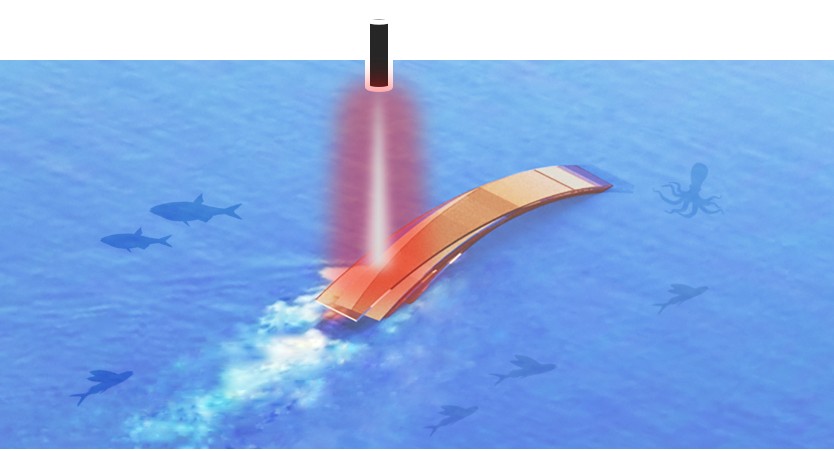
It’s not a drone, but its University of California Riverside inventors say it is robotic: a film powered by light, capable of being configured to soak up oil spills in the ocean or contaminating liquids from freshwater supplies. It’s therefore non-dronishly cool enough to write about here.
“It” is Neusbot, a robotic film designed to use solar and other light energy to power it across the surface of oceans, lakes, or reservoirs while it absorbs harmful floating impurities. Neusbot takes its name from neustons, a family of insects that includes water striders – those winged aquatic Daddy Longlegs known to many a creek- or stream-savvy tot as “skeeters.” Like the UC Riverside film they inspired, neustons take advantage of their lightweight, relative buoyancy, and ability to create pulsations as a means of skittering across the surface of waterways they inhabit.
The big difference between the two is, of course, that Neusbot was created by humans to pull the feat off, while neustons learned the trick through millions of years of evolution in nature.
The way the film functions is similar to steam engines that powered the early trains. Neusbot contains three layers, the middle of which is porous and filled with water. It also holds iron oxide and copper nanorods, the latter of which converts ambient light into energy that in turn transforms the water into steam. That provokes the twitching and pulsating motions within the film that move it across the surface of the surrounding water.
Its UC Riverside inventors, chemists Zhiwei Li and Yadong Yin, are preparing to add a fourth layer to the robotic film that can absorb oil or other chemicals in water. When that happens, it can be used as a self-driving marine vacuum cleaner for several kinds of pollution.
“Our motivation was to make soft robots sustainable and able to adapt on their own to changes in the environment,” said Li. “If sunlight is used for power, this machine is sustainable, and won’t require additional energy sources. The film is also re-usable.”
A major advance in the concept over similar pliable film technologies was getting Neusbot to generate adjustable mechanical oscillations as its means of locomotion. Most others could be made to bend but not bop around.
Meanwhile, Li and Yin also managed to get Neusbot to respond to light sources other than just the sun. That makes it capable of multidirectional movement rather than simply following the strongest source of solar rays – meaning operators can direct where it moves.
“There aren’t many methods to achieve this controllable movement using light,” Li noted. “We solved the problem with a tri-layer film that behaves like a steam engine.“
That third, bottom layer of the robotic film, meanwhile, is hydrophobic – a water-repelling characteristic that will always bring up to the surface, even if dunked by waves. Its component nanomaterials are also highly resistant to high salt levels, nearly eliminating the risk of corrosion. All that remains, Li says, is for the fourth, pollution-absorbing layer to be added for Neusbot to start cleaning up messes humans keep making in the planet’s waterways.
“Normally, people send ships to the scene of an oil spill to clean by hand,” he comments. “Neusbot could do this work like a robot vacuum, but on the water’s surface.”
FTC: We use income earning auto affiliate links. More.




Comments